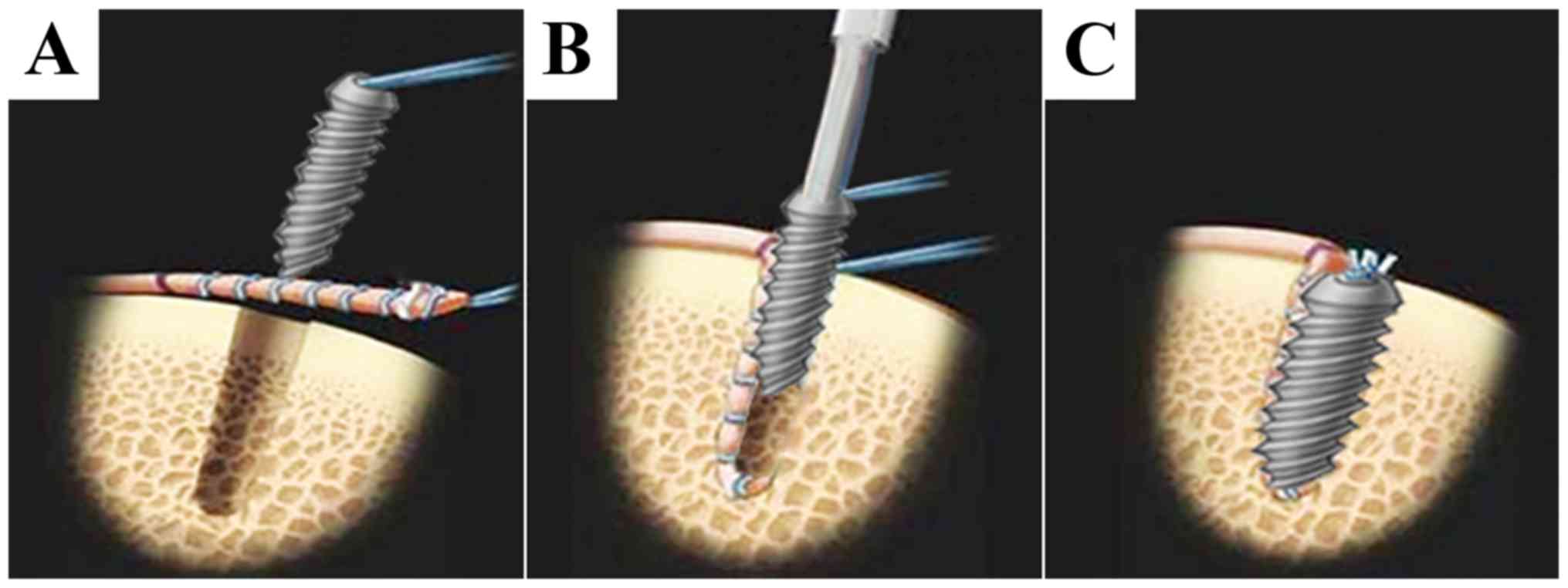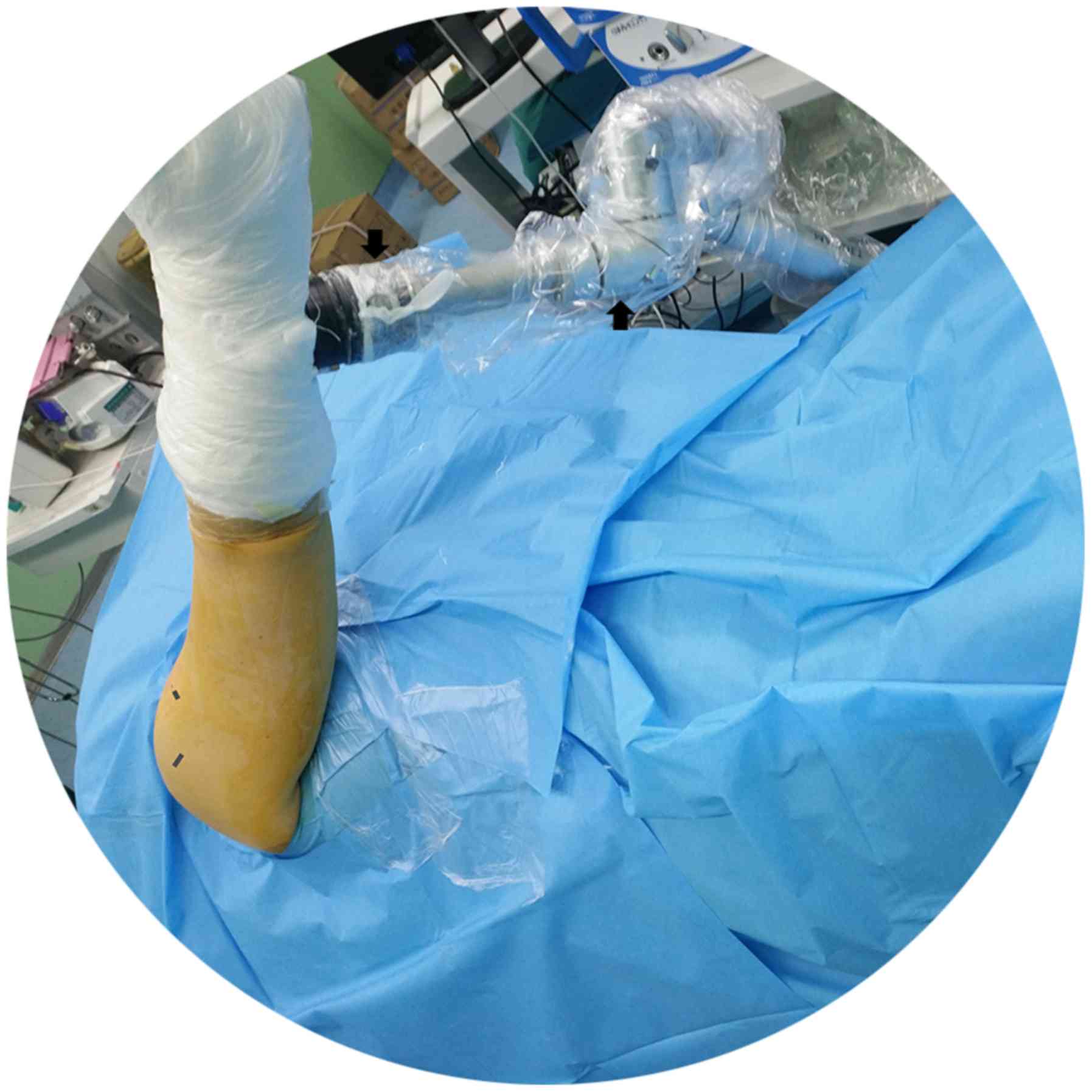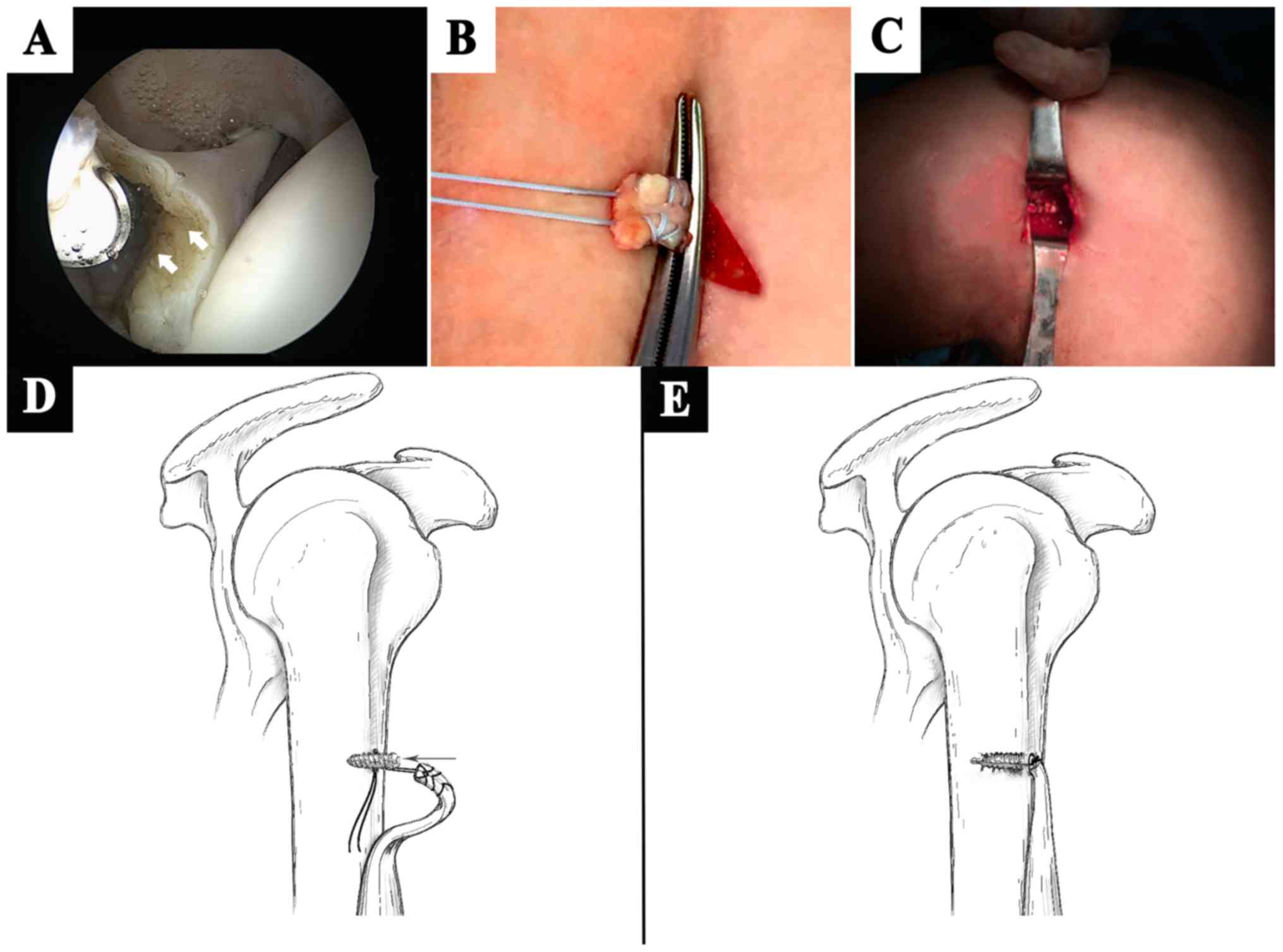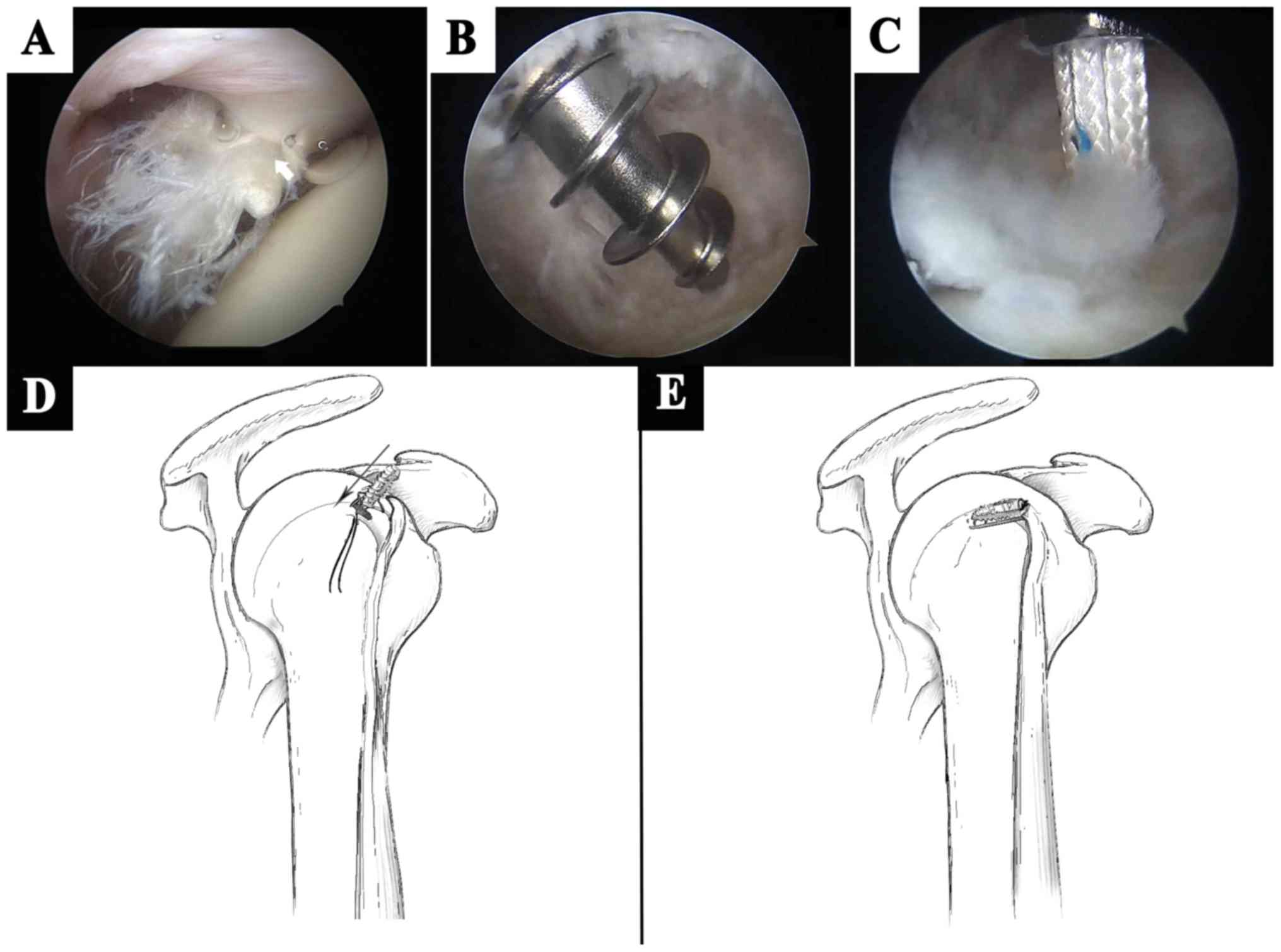|
1
|
Boileau P, Baqué F, Valerio L, Ahrens P,
Chuinard C and Trojani C: Isolated arthroscopic biceps tenotomy or
tenodesis improves symptoms in patients with massive irreparable
rotator cuff tears. J Bone Joint Surg Am. 89:747–757. 2007.
View Article : Google Scholar : PubMed/NCBI
|
|
2
|
Landreau P, Catteeuw A, Hamie F, Saithna
A, Sonnery-Cottet B and Smigielski R: Anatomic study and reanalysis
of the nomenclature of the anterolateral complex of the knee
focusing on the distal iliotibial band: Identification and
description of the condylar strap. Orthop J Sports Med.
7:23259671188180642019. View Article : Google Scholar : PubMed/NCBI
|
|
3
|
Ataoglu MB, Cetinkaya M, Ozer M, Ayanoglu
T and Kanatli U: The high frequency of superior labrum, biceps
tendon, and superior rotator cuff pathologies in patients with
subscapularis tears: A cohort study. J Orthop Sci. 23:304–309.
2018. View Article : Google Scholar : PubMed/NCBI
|
|
4
|
Kennedy NI, Sanchez G, Mannava S, Ferrari
MB, Frangiamore SJ and Provencher MT: Arthroscopic rotator cuff
repair with mini-open subpectoral biceps tenodesis. Arthrosc Tech.
6:e1667–e1674. 2017. View Article : Google Scholar : PubMed/NCBI
|
|
5
|
Su WR, Budoff JE and Lou JP: The effect of
posterosuperior rotator cuff tears and biceps loading on
glenohumeral translation. Arthroscopy. 26:578–586. 2010. View Article : Google Scholar : PubMed/NCBI
|
|
6
|
Desai SS and Mata HK: Long head of biceps
tendon pathology and results of tenotomy in full-thickness
reparable rotator cuff tear. Arthroscopy. 33:1971–1976.
2017.PubMed/NCBI
|
|
7
|
Hassan S and Patel V: Biceps tenodesis
versus biceps tenotomy for biceps tendinitis without rotator cuff
tears. J Clin Orthop Trauma. 10:248–256. 2019. View Article : Google Scholar : PubMed/NCBI
|
|
8
|
Forsythe B, Agarwalla A, Puzzitiello RN,
Mascarenhas R and Werner BC: Rates and risk factors for revision
open and arthroscopic proximal biceps tenodesis. Orthop J Sports
Med. 7:23259671188254732019. View Article : Google Scholar : PubMed/NCBI
|
|
9
|
Godenèche A, Nové-Josserand L, Audebert S,
Toussaint B, Denard PJ; French Society for Arthroscopy (SFA), ;
Lädermann A: Relationship between subscapularis tears and injuries
to the biceps pulley. Knee Surg Sports Traumatol Arthrosc.
25:2114–2120. 2017. View Article : Google Scholar : PubMed/NCBI
|
|
10
|
Lee SH, Nam DJ, Kim SJ and Kim JW:
Comparison of clinical and structural outcomes by subscapularis
tendon status in massive rotator cuff tear. Am J Sports Med.
45:2555–2562. 2017. View Article : Google Scholar : PubMed/NCBI
|
|
11
|
Motley GS, Guengerich B, Schuller T and
Turbyfill A: The ramp test: An arthroscopic technique for
confirming intra-articular subluxation and instability of the long
head of the biceps tendon within the shoulder. Arthrosc Tech.
7:e327–e330. 2018. View Article : Google Scholar : PubMed/NCBI
|
|
12
|
Osti L, Buda M, Buono AD, Osti R and
Massari L: Clinical evidence in the treatment of rotator cuff tears
with hyaluronic acid. Muscles Ligaments Tendons J. 5:270–275. 2016.
View Article : Google Scholar : PubMed/NCBI
|
|
13
|
Shi LL, Mullen MG, Freehill MT, Lin A,
Warner JJ and Higgins LD: Accuracy of long head of the biceps
subluxation as a predictor for subscapularis tears. Arthroscopy.
31:615–619. 2015. View Article : Google Scholar : PubMed/NCBI
|
|
14
|
Watson ST, Robbins CB, Bedi A, Carpenter
JE, Gagnier JJ and Miller BS: Comparison of outcomes 1 year after
rotator cuff repair with and without concomitant biceps surgery.
Arthroscopy. 33:1928–1936. 2017.PubMed/NCBI
|
|
15
|
Duchman KR, DeMik DE, Uribe B, Wolf BR and
Bollier M: Open versus arthroscopic biceps tenodesis: A comparison
of functional outcomes. Iowa Orthop J. 36:79–87. 2016.PubMed/NCBI
|
|
16
|
Green JM, Getelman MH, Snyder SJ and Burns
JP: All-Arthroscopic suprapectoral versus open subpectoral
tenodesis of the long head of the biceps brachii without the use of
interference screws. Arthroscopy. 33:19–25. 2017. View Article : Google Scholar : PubMed/NCBI
|
|
17
|
Xu GJ and Dai XS: Tenotomy fixed on distal
trochlea under arthroscopy for long head of biceps tendon and
rotator cuff tear. Zhongguo Gu Shang. 31:612–616. 2018.(In
Chinese). PubMed/NCBI
|
|
18
|
Veen EJD, Koorevaar CT and Diercks RL:
Using the long head of biceps tendon autograft as an anatomical
reconstruction of the rotator cable: An arthroscopic technique for
patients with massive rotator cuff tears. Arthrosc Tech.
7:e699–e703. 2018. View Article : Google Scholar : PubMed/NCBI
|
|
19
|
Saithna A, Longo A, Leiter J, Old J and
MacDonald PM: Shoulder arthroscopy does not adequately visualize
pathology of the long head of biceps tendon. Orthop J Sports Med.
4:23259671156239442016. View Article : Google Scholar : PubMed/NCBI
|
|
20
|
Meraner D, Sternberg C, Vega J, Hahne J,
Kleine M and Leuzinger J: Arthroscopic tenodesis versus tenotomy of
the long head of biceps tendon in simultaneous rotator cuff repair.
Arch Orthop Trauma Surg. 136:101–106. 2016. View Article : Google Scholar : PubMed/NCBI
|
|
21
|
Zhang Q, Zhou J, Ge H and Cheng B:
Tenotomy or tenodesis for long head biceps lesions in shoulders
with reparable rotator cuff tears: A prospective randomised trial.
Knee Surg Sports Traumatol Arthrosc. 23:464–469. 2015. View Article : Google Scholar : PubMed/NCBI
|
|
22
|
Oh JH, Lee YH, Kim SH, Park JS, Seo HJ,
Kim W and Park HB: Comparison of treatments for superior
labrum-biceps complex lesions with concomitant rotator cuff repair:
A prospective, randomized, comparative analysis of debridement,
biceps tenotomy, and biceps tenodesis. Arthroscopy. 32:958–967.
2016. View Article : Google Scholar : PubMed/NCBI
|
|
23
|
Franceschi F, Longo UG, Ruzzini L,
Rizzello G, Maffulli N and Denaro V: No advantages in repairing a
type II superior labrum anterior and posterior (SLAP) lesion when
associated with rotator cuff repair in patients over age 50: A
randomized controlled trial. Am J Sports Med. 36:247–253. 2008.
View Article : Google Scholar : PubMed/NCBI
|
|
24
|
De Carli A, Vadalà A, Zanzotto E, Zampar
G, Vetrano M, Iorio R and Ferretti A: Reparable rotator cuff tears
with concomitant long-head biceps lesions: Tenotomy or
tenotomy/tenodesis? Knee Surg Sports Traumatol Arthrosc.
20:2553–2558. 2012. View Article : Google Scholar : PubMed/NCBI
|
|
25
|
Koh KH, Ahn JH, Kim SM and Yoo JC:
Treatment of biceps tendon lesions in the setting of rotator cuff
tears: Prospective cohort study of tenotomy versus tenodesis. The
Am J Sports Med. 38:1584–1590. 2010. View Article : Google Scholar : PubMed/NCBI
|
|
26
|
Cho NS, Cha SW and Rhee YJ: Funnel
tenotomy versus intracuff tenodesis for lesions of the long head of
the biceps tendon associated with rotator cuff tears. Am J Sports
Med. 42:1161–1168. 2014. View Article : Google Scholar : PubMed/NCBI
|
|
27
|
Karlsson J: In reparable rotator cuff
tears with lesions of the long head of the biceps brachii tendon,
tenotomy did not differ from tenodesis in terms of function or
pain. J Bone Joint Surg Am. 99:3512017. View Article : Google Scholar : PubMed/NCBI
|
|
28
|
Ikemoto RY, Pileggi PE, Murachovsky J,
Nascimento LG, Serpone RB, Strose E and Oliveira LH: Tenotomy with
or without tenodesis of the long head of the biceps using repair of
the rotator cuff. Rev Bras Ortop. 47:736–740. 2015. View Article : Google Scholar : PubMed/NCBI
|
|
29
|
Kukkonen J, Rantakokko J, Virolainen P and
Aärimaa V: The effect of biceps procedure on the outcome of rotator
cuff reconstruction. ISRN Orthop. 2013:8409652013. View Article : Google Scholar : PubMed/NCBI
|
|
30
|
Sentürk I, Ozalay M, Akpınar S, Leblebici
B, Cınar BM and Tuncay C: Clinical and isokinetic comparison
between tenotomy and tenodesis in biceps pathologies. Acta Orthop
Traumatol Turc. 45:41–46. 2011. View Article : Google Scholar : PubMed/NCBI
|
|
31
|
Delle Rose G, Borroni M, Silvestro A,
Garofalo R, Conti M, De Nittis P and Castagna A: The long head of
biceps as a source of pain in active population: Tenotomy or
tenodesis? A comparison of 2 case series with isolated lesions.
Musculoskelet Surg. 96 (Suppl 1):S47–S52. 2012. View Article : Google Scholar : PubMed/NCBI
|
|
32
|
Ahmad CS, DiSipio C, Lester J, Gardner TR,
Levine WN and Bigliani LU: Factors affecting dropped biceps
deformity after tenotomy of the long head of the biceps tendon.
Arthroscopy. 23:537–541. 2007. View Article : Google Scholar : PubMed/NCBI
|
|
33
|
Klinger HM, Spahn G, Baums MH and Steckel
H: Arthroscopic debridement of irreparable massive rotator cuff
tears-a comparison of debridement alone and combined procedure with
biceps tenotomy. Acta Chir Belg. 105:297–301. 2005. View Article : Google Scholar : PubMed/NCBI
|
|
34
|
Friedman JL, FitzPatrick JL, Rylander LS,
Bennett C, Vidal AF and McCarty EC: Biceps tenotomy versus
tenodesis in active patients younger than 55 years: Is there a
difference in strength and outcomes? Orthop J Sports Med.
3:23259671155708482015. View Article : Google Scholar : PubMed/NCBI
|
|
35
|
Gervasi E, Sebastiani E and Cautero E:
No-holes transpectoral tenodesis technique tenotomy of the long
head of the biceps brachii. Muscles Ligaments Tendons J. 6:427–432.
2016. View Article : Google Scholar : PubMed/NCBI
|
|
36
|
Park JY, Lee JH, Oh KS, Chung SW, Bang JY
and Noh YM: Bridge Tenodesis: A Secure fixation technique for
biceps long head tendinopathy during arthroscopic rotator cuff
repair using a suture-bridge technique. Arthrosc Tech.
5:e1077–e1081. 2016. View Article : Google Scholar : PubMed/NCBI
|
|
37
|
Nassos JT and Chudik SC: Arthroscopic
rotator cuff repair with biceps tendon augmentation. Am J Orthop
(Belle Mead NJ). 38:279–281. 2009.PubMed/NCBI
|
|
38
|
Elser F, Braun S, Dewing CB, Giphart JE
and Millett PJ: Anatomy, function, injuries, and treatment of the
long head of the biceps brachii tendon. Arthroscopy. 27:581–592.
2011. View Article : Google Scholar : PubMed/NCBI
|
|
39
|
Hufeland M, Kolem C, Ziskoven C, Kircher
J, Krauspe R and Patzer T: The influence of suprapectoral
arthroscopic biceps tenodesis for isolated biceps lesions on elbow
flexion force and clinical outcomes. Knee Surg Sports Traumatol
Arthrosc. 25:3220–3228. 2017. View Article : Google Scholar : PubMed/NCBI
|
|
40
|
Faruqui S, Kotob MA, Hanna CC and Foad A:
The modified Norwegian method of biceps tenodesis: How well does it
work? Knee Surg Sports Traumatol Arthrosc. 25:3264–3269. 2017.
View Article : Google Scholar : PubMed/NCBI
|
|
41
|
Chen CH, Hsu KY, Chen WJ and Shih CH:
Incidence and severity of biceps long head tendon lesion in
patients with complete rotator cuff tears. J Trauma. 58:1189–1193.
2005. View Article : Google Scholar : PubMed/NCBI
|
|
42
|
Jeong JY, Park SM, Park YE and Yoo JC:
Morphological classification of anatomical variants of the
intra-articular portion of the long head of the biceps brachii
tendon and analysis of the incidence and the relationship with
shoulder disease for each subtype. J Orthop Surg (Hong Kong).
25:23094990177422072017. View Article : Google Scholar : PubMed/NCBI
|
|
43
|
Ciccotti MG: Editorial commentary: The
long head of the biceps brachii tendon-the shoulder surgeon's
conundrum. Arthroscopy. 33:1937–1939. 2017. View Article : Google Scholar : PubMed/NCBI
|
|
44
|
Frost A, Zafar MS and Maffulli N: Tenotomy
versus tenodesis in the management of pathologic lesions of the
tendon of the long head of the biceps brachii. Am J Sports Med.
37:828–833. 2009. View Article : Google Scholar : PubMed/NCBI
|
|
45
|
Barber FA, Byrd JW, Wolf EM and Burkhart
SS: How would you treat the partially torn biceps tendon.
Arthroscopy. 17:636–639. 2001. View Article : Google Scholar : PubMed/NCBI
|
|
46
|
Kelly AM, Drakos MC, Fealy S, Taylor SA
and O'Brien SJ: Arthroscopic release of the long head of the biceps
tendon: Functional outcome and clinical results. Am J Sports Med.
33:208–213. 2005. View Article : Google Scholar : PubMed/NCBI
|
|
47
|
Maynou C, Mehdi N, Cassagnaud X, Audebert
S and Mestdagh H: Clinical results of arthroscopic tenotomy of the
long head of the biceps brachii in full thickness tears of the
rotator cuff without repair: 40 cases. Rev Chir Orthop Réparatrice
Appar Mot. 91:300–306. 2005.(In French). View Article : Google Scholar
|
|
48
|
Kim YS, Jeong JY and Lee HJ: Arthroscopic
tenodesis of the long head of the biceps tendon. JBJS Essent Surg
Tech. 7:e192017. View Article : Google Scholar : PubMed/NCBI
|
|
49
|
Ge H, Zhang Q, Sun Y, Li J, Sun L and
Cheng B: Tenotomy or tenodesis for the long head of biceps lesions
in shoulders: A systematic review and meta-analysis. PLoS One.
10:e01212862015. View Article : Google Scholar : PubMed/NCBI
|
|
50
|
Shang X, Chen J and Chen S: A
meta-analysis comparing tenotomy and tenodesis for treating rotator
cuff tears combined with long head of the biceps tendon lesions.
PLoS One. 12:e01857882017. View Article : Google Scholar : PubMed/NCBI
|
|
51
|
Lee HJ, Jeong JY, Kim CK and Kim YS:
Surgical treatment of lesions of the long head of the biceps
brachii tendon with rotator cuff tear: A prospective randomized
clinical trial comparing the clinical results of tenotomy and
tenodesis. J Shoulder Elbow Surg. 25:1107–1114. 2016. View Article : Google Scholar : PubMed/NCBI
|
|
52
|
Leroux T, Chahal J, Wasserstein D, Verma
NN and Romeo AA: A systematic review and meta-analysis comparing
clinical outcomes after concurrent rotator cuff repair and long
head biceps tenodesis or tenotomy. Sports Health. 7:303–307. 2015.
View Article : Google Scholar : PubMed/NCBI
|
|
53
|
Hsu AR, Ghodadra NS, Provencher MT, Lewis
PB and Bach BR: Biceps tenotomy versus tenodesis: A review of
clinical outcomes and biomechanical results. J Shoulder Elbow Surg.
20:326–332. 2011. View Article : Google Scholar : PubMed/NCBI
|
|
54
|
Yi Y, Lee JM, Kwon SH and Kim JW:
Arthroscopic proximal versus open subpectoral biceps tenodesis with
arthroscopic repair of small or medium-sized rotator cuff tears.
Knee Surg Sports Traumatol Arthrosc. 24:3772–3778. 2016. View Article : Google Scholar : PubMed/NCBI
|
|
55
|
Gombera MM, Kahlenberg CA, Nair R,
Saltzman MD and Terry MA: All-arthroscopic suprapectoral versus
open subpectoral tenodesis of the long head of the biceps brachii.
Am J Sports Med. 43:1077–1083. 2015. View Article : Google Scholar : PubMed/NCBI
|
|
56
|
Biz C, Vinanti GB, Rossato A, Arnaldi E
and Aldegheri R: Prospective study of three surgical procedures for
long head biceps tendinopathy associated with rotator cuff tears.
Muscles Ligaments Tendons J. 2:133–136. 2012.PubMed/NCBI
|
|
57
|
Werner BC, Lyons ML, Evans CL, Griffin JW,
Hart JM, Miller MD and Brockmeier SF: Arthroscopic suprapectoral
and open subpectoral biceps tenodesis: A comparison of restoration
of length-tension and mechanical strength between techniques.
Arthroscopy. 31:620–627. 2015. View Article : Google Scholar : PubMed/NCBI
|
|
58
|
Lutton DM, Gruson KI, Harrison AK,
Gladstone JN and Flatow EL: Where to tenodese the biceps: Proximal
or distal? Clin Orthop Relat Res. 469:1050–1055. 2011. View Article : Google Scholar : PubMed/NCBI
|
|
59
|
Bennett WF: Visualization of the anatomy
of the rotator interval and bicipital sheath. Arthroscopy.
17:107–111. 2001. View Article : Google Scholar : PubMed/NCBI
|
|
60
|
Hart ND, Golish SR and Dragoo JL: Effects
of arm position on maximizing intraarticular visualization of the
biceps tendon: A cadaveric study. Arthroscopy. 28:481–485. 2012.
View Article : Google Scholar : PubMed/NCBI
|
|
61
|
Taylor SA, Khair MM, Gulotta LV, Pearle
AD, Baret NJ, Newman AM, Dy CJ and O'Brien SJ: Diagnostic
glenohumeral arthroscopy fails to fully evaluate the biceps-labral
complex. Arthroscopy. 31:215–224. 2015. View Article : Google Scholar : PubMed/NCBI
|
|
62
|
Festa A, Allert J, Issa K, Tasto JP and
Myer JJ: Visualization of the extra-articular portion of the long
head of the biceps tendon during intra-articular shoulder
arthroscopy. Arthroscopy. 30:1413–1417. 2014. View Article : Google Scholar : PubMed/NCBI
|
|
63
|
Gilmer BB, DeMers AM, Guerrero D, Reid JB
III, Lubowitz JH and Guttmann D: Arthroscopic versus open
comparison of long head of biceps tendon visualization and
pathology in patients requiring tenodesis. Arthroscopy. 31:29–34.
2015. View Article : Google Scholar : PubMed/NCBI
|
|
64
|
Moon SC, Cho NS and Rhee YG: Analysis of
‘hidden lesions’ of the extra-articular biceps after subpectoral
biceps tenodesis: The subpectoral portion as the optimal tenodesis
site. Am J Sports Med. 43:63–68. 2015. View Article : Google Scholar : PubMed/NCBI
|














